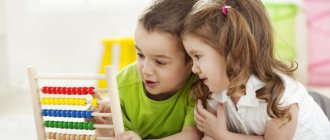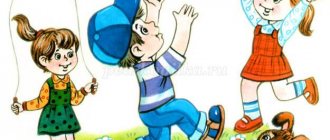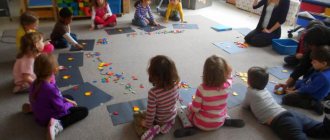The requirements of the modern school curriculum are such that by the time a child enters first grade, elementary mathematical concepts must be formed. These include knowledge of numbers and basic symbols, ability to count within ten and cope with simple math problems that require addition and subtraction for children aged 5-6 years. At the same time, as is known, preschool children absorb information that is presented in a playful form much faster and easier. Specialists from the development site “Razumeikin” sought to take these factors into account when preparing online tasks for teaching mathematics to 5-year-old children. All exercises are presented in an easy, interesting way.
The “Other Mathematical Concepts” section introduces the child to the basic symbols (“greater than,” “less than,” and “equal to”) and teaches them how to use them. Using our website you can study easily and productively. By completing math problems, 6-year-old preschoolers learn ordinal counting and the basics of measuring length, mass, and volume. Children learn to understand and analyze the dependence of the measurement result on the measurement value. Assignments as part of the online mathematics training program for children 5-6 years old give an idea of the basic geometric shapes and bodies in pictures, as well as a basic concept of tables.
When developing a set of exercises for children of senior preschool age, our specialists tried to make them not only as understandable and exciting as possible, but also truly useful in practical terms. Almost all online math tasks for 6-year-old children are designed in the form of a game and have detailed explanations. You can find them in the training video before the exercise. An explanation for the test tasks in the section “Mathematics for preschoolers 5-6 years old” is also given if the answer the child gave turned out to be incorrect or insufficiently complete.
How are results assessed?
For completing mathematics assignments for preschoolers 5 years old, the Razumeikin website provides a whole system of rewards. We are convinced that it helps to increase children's interest in learning and create positive motivation.
By completing the tasks in the “Mathematics for preschoolers 5 years old” section, kids receive a reward. Our website provides medals, cups, pennants and certificates.
Almost all task-games in the “Mathematics for 6-year-old children” section are graded depending on the attempt at which the child gave the correct answer. If necessary, you can return to the completed exercise. By doing the task in the section “Mathematics for preschoolers 5-6 years old” again, the child will be able to improve the previous result and receive a higher reward.
Before you start doing the exercises in the “Mathematics for children 5-6 years old” section, we recommend taking a test. The results obtained will help you understand which topics need to be discussed in more detail. In addition, parents will be able to determine which tasks in the “Mathematics for preschoolers 6 years old” section should be completed first.
Entertaining mathematics in pictures
Entertaining math material for preschool children.
All preschool children are real little explorers. They discover the whole world that surrounds them. Teachers and parents should work together to support the child in these explorations. They should try to maintain and develop the preschooler’s desire for knowledge and satisfy the desire for active activity, constantly fueling interest in the process of studying the world around him. Math games for preschoolers will be an excellent help with this.
The role and purposes of mathematical games
It is obvious that from birth a child needs to develop all his muscles. But they are not the only ones that require attention. The mind also needs constant training. After all, a person who is able to think logically easily copes with solving all life problems. He is able to make decisions faster, find a way out of difficult situations, and is more mobile and efficient.
The role of didactic games in the mathematical development of preschool children is great. It is through them that the knowledge of mathematics as a science and passion for it begins.
To develop logical thinking and mathematical abilities (and one is closely related to the other), it is necessary to use special games. This is the only way to instill an interest in mathematics.
The main goals of learning mathematics in the game for preschoolers:
· development of logical thinking;
· development of independence and the ability to solve problems without the help of adults;
· formation of interest in creative and cognitive activity;
· accumulation of logical and mathematical experience;
· familiarity with basic mathematical concepts from a very young preschool age;
· familiarity with basic operations: addition, subtraction, counting, etc.
Important!
You cannot stop using didactic games in middle and older preschool age. For the full development of mathematical abilities, it is necessary to train children year after year.
Types of tasks in mathematics
Preschool children are divided into three age groups:
junior (3-4 years), middle (4-5 years), senior (5-6 years). It happens that there is another group - preparatory - which includes children 6-7 years old. It is in accordance with the age category that it is necessary to select didactic games for young mathematicians.
Didactic activities are divided into the following:
· games;
· puzzles;
· joke tasks;
· puzzles;
· work with geometric material.
Important!
You should not play educational games in mathematics for too long. This is especially true for younger preschoolers. Initially, it is enough to conduct such exercises for 5 minutes a day.
DIY didactic games
To enhance the cognitive interest of students, teachers try to attract their attention in all possible ways. To achieve this goal, many parents and educators develop do-it-yourself math books for preschoolers. To make them, you can use any available material:
· fabric, threads, buttons;
· natural materials;
· stationery;
· imagination, it is given special importance in the creative process.
Examples include the following games:
· “Find the odd one out.” The game is played with the goal of analyzing geometric shapes, the ability to compare them and find what is superfluous. Children are asked to analyze rows of geometric shapes cut out of cardboard or other material and find the mistake in it. It may consist, for example, in finding a triangle among circles or distinguishing a figure from others by color.
· “Who are the neighbors.” This game requires only one additional item - a ball. With its help, the skill of naming neighbors of numbers is improved. Children stand in a circle, the teacher throws the ball and calls a random number. The child must catch the ball and name its neighbors.
· "Harvesting". The goal of this game is to develop the skill of comparing objects by size. Two baskets are placed in front of the children. You need to put large fruits and vegetables in one of them, and small ones in the second.
· Mathematical games for perception and memory training
· The most popular game is "Confusion". It is suitable for preschoolers of all age groups. Its meaning is as follows: cards with numbers from 1 to 9 are laid out on the table in random order. The child must arrange them in ascending or, conversely, descending order. For the little ones, you can use two or three numbers, gradually increasing the number of cards.
· “Clap your hands.” A very simple and interesting game. The teacher calls any number, and the child must clap his hands as many times as there are units in this number.
· "Do not snooze!". Cards with numbers are laid out on the table in front of the child, which are easy to make yourself. The teacher tells a fairy tale in which various numbers appear. As soon as any of them sounds, the children must quickly pick up the corresponding card.
Modern interactive tasks also play an important role in the development of mathematical abilities in preschool children through play activities. They must be selected taking into account the Federal State Educational Standard and correspond to the age category of the pupils.
Mathematical problems for ingenuity
Mathematical problems requiring ingenuity occupy a place of honor among all tasks. Children really like such exercises and develop a flexible, plastic mind and intelligence.
Examples:
· “There are 4 corners in the room, a cat sits in each corner, and opposite each cat there are 3 cats. How many cats are there in the room? (4 cats);
· “An animal has 2 right legs, 2 left legs, 2 legs in front, 2 in back. How many legs does he have? (total 4);
· “There were 7 brothers walking, each brother had one sister. How many people walked? (8 people);
· “7 boys cleared 1 path in the garden. How many paths did the boys clear?” (7 tracks).
Riddles, comic problems, entertaining questions
Such tasks, as a rule, arouse the greatest interest among children. This category includes both fun, simple tasks and didactic number composition games for preschoolers.
Examples:
· “Continue the phrase: if Sasha left the house before Seryozha, then Seryozha...” (left the house later than Sasha).
· “Guess the riddle in verse:
There's a puppy sitting on the porch
Warms his fluffy side.
The second one came running
And he sat down like a hero. How many puppies are there?
· “Grandma Dasha has a granddaughter Masha, a cat Fluff, and a dog Druzhok. How many grandchildren does grandma have?”
· The significance of such exercises: children are introduced to active mental activity and master the necessary counting skills. Thanks to such tasks, numeracy skills are developed quietly and in a light-hearted manner.
· Important!
All games and tasks must be selected taking into account the age group of the students. Young children will not be able to cope with difficult tasks, which can lead to a loss of interest in the subject and even a decrease in self-esteem.
· Older people, on the contrary, will not want to think about tasks that are too easy. They will simply not be interested in them. As a result, there may be a misconception about mathematics - children will consider it too difficult, older children - easy.
· All types of didactic games in mathematics contribute to the development of interest in numbers, problems and counting in children, starting from a very early age. With mathematical and logical thinking skills, a child’s adaptation to school is much faster. In the process of studying, children learn to reason, analyze and generalize the information received.
Examples within 10
Gradually, the child will be better and better at calculating within 10. To learn how to “crack” examples like nuts, you need to solve a lot. But simply solving the same type of examples is boring. Math should be interesting!
So that your child can practice writing examples at any time, we have come up with ready-made tasks for you. Just download, print and get started!
Methodological material “Collection of problems”. Mathematics for children 5-7 years old.
Author: Enina Svetlana Nikolaevna,
teacher of MBDOU "General developmental kindergarten No. 112", Voronezh.
This material is designed for children aged 5–7 years who are preparing to enter school.
It is recommended for a wide range of specialists working with children of this age - educators, additional education teachers, teachers, as well as parents who want to prepare their child for school.
Goal: to develop the ability to solve arithmetic problems involving addition and subtraction within ten.
Collection of problems. Mathematics for children 5-7 years old.
1. There were 8 pikes in the lake. Ivan caught 1 pike. How many pike are left in the lake?
2. The fisherman caught 7 crucian carp and put them in a bucket. Vaska the cat stole 6 crucian carp. How many crucian carp are left in the bucket?
3. To cook the fish soup, 7 of the eight carp caught were put in a pan, the rest were given to the cat. How many carp did the cat get for dinner?
4. Dad brought 4 perches and 3 roach from fishing. How many perches and roaches did dad catch?
5. Grandma bought 8 crucian carp at the store and fried half of them for lunch. How many crucian carp are left?
6. There were 7 fish on the display window in the store, 4 of them were pike, the rest were bream. How many bream were on the display?
7. In the yard, 3 white and 6 gray pigeons were pecking for crumbs. How many white and gray pigeons dined in the yard?
8. 9 sparrows were sitting on a bush. 8 sparrows flew away. How many sparrows continued to sit on the bush?
9. 7 bullfinches flew to the rowan bush, 6 of them landed on the lower branch, the rest - on the upper one. How many bullfinches are on the top branch?
10. A pet store sold 6 parrots. By the end of the day, 5 parrots were bought. How many parrots are left to wait for their owner?
11. 4 bugs hid under the bench and the same number under the chair. How many bugs are there hiding from the villainous spider?
12. First, the Tsokotukha Fly put 8 cups on the table, then 2 more. How many guests did the fly invite in total?
13. Grandmother had 3 gray goats and 4 white ones. How many gray and white goats did grandma have?
14. In the morning 6 sheep were sheared, and in the evening 3 more. How many sheep were sheared that day?
15. A blacksmith needs to shoe 8 horses. He has already shod 5. How many horses does the blacksmith have left to shoe?
16. 9 horses were brought to a watering place. 8 of them entered the river. How many horses are left on the shore?
17. The grandmother milked 5 cows, and the granddaughter milked 2. How many cows were milked in total?
18. Naf-Naf collected 5 acorns, the brothers ate 4 acorns. How many acorns did Naf-Naf get?
19. To feed the moose in winter, the forester laid out 10 armfuls of hay. The moose have already eaten 5 armfuls. How many armfuls of hay will the moose eat later?
20. The children launched 7 boats down the stream, and then 3 more. How many boats did the children launch in total?
21. There were 5 icicles hanging above the window. During the day the sun warmed up and 2 icicles melted. How many icicles continued to sparkle in the sun?
22. In autumn, the garden is harvested. 4 heads of cabbage were taken from one bed, and the same number from another bed. How many heads of cabbage were produced in these beds?
23. In the first week of October, only one day was sunny, the rest were rainy. How many rainy days have there been this week?
24. Mom works as a teacher. Today she needs to check 10 notebooks. She has already checked 3 notebooks. How many notebooks are left to check?
25. On Tuesday my mother received 7 calls on her mobile phone. Mom answered 5 calls. How many calls did mom miss that day?
26. To prevent the bun from rolling far from the house, the grandmother told the grandfather to make a fence. To build it you need 10 pegs. Grandfather has already planed 8 pegs. How many pegs does grandpa have left to make?
27. Tanya and Vanya picked flowers for their grandmother from the field - 5 daisies and 4 bells. How many flowers did the brother and sister give to their grandmother?
28. There were 10 children in the group. After lunch, six were taken. How many children are left for quiet time?
29. 8 students went to the school canteen for breakfast. 5 children chose cocoa, the rest chose tea. How many children drank tea?
30. Mom sent the children to the store. Tanya bought 3 apples, and Vanya bought 6 pears. How many pears did the children buy?
31. In the morning, 6 cars of bricks were brought to the construction site, and in the afternoon - 3 more cars. How many trucks of bricks were brought to build the house that day?
32. Renovation has begun in the nine entrance building. So far, only 2 entrances have been repaired. How many entrances remain to be repaired?
33. Malvina had 10 dresses, 8 of them she gave for washing. How many dresses are left hanging in Malvina’s closet?
34. There were 9 people traveling in the carriage. 2 people at the nearest station got off. How many people continued their journey in this carriage?
35. There were 10 people standing in line at the metro ticket office. 9 people bought tickets and left. How many people are left near the cash register?
36. Karabas Barabas had 10 dolls. Two dolls did not participate in the evening performance. How many dolls took part in this performance?
37. Yesterday Pierrot came up with 2 poems, and today – 5. How many poems did Pierrot come up with these days?
38. In the morning, Malvina asked for 2 minutes to wash her face and 3 minutes to brush her teeth. How long did it take Malvina to do her morning toilet?
39. Mashenka told the bear to chop 8 logs for the stove. The bear only chopped 3. How many logs does he have left to chop?
40. In the morning Mashenka baked 4 pies with cabbage and 5 with raspberries for the bear. How many pies did Mashenka bake in total?






